Sliding Hardware Systems: An Essential Tool for Saving Space in Commercial and Residential Spaces
![]() Continuing Education
Continuing Education
Use the following learning objectives to focus your study while reading this month’s Continuing Education article.
Learning Objectives - After reading this article, you will be able to:
- Explain the benefits and design efficiencies of architectural sliding hardware systems, including cost savings, accessibility and flexibility.
- Discuss wide-ranging project applications for architectural sliding hardware systems.
- Explain the key components and materials that comprise a basic architectural sliding hardware system.
- Select the most appropriate architectural sliding hardware system for a project based on functionality and aesthetics.
In the never-ending pursuit of efficiency in design, space continues to be one of the most valuable assets in the built environment, putting a premium importance on the tools and techniques that enable the design community to make the most out of every square foot. Beyond simply offering building systems, furniture, and technology in more compact models, today’s product innovations are flipping the traditional methodologies on their heads, finding new ways to accomplish design objectives that make better use of space.
One of the most established and egregious space wasters is the door hinge, requiring that a significant amount of space remain free and clear, so that the door may swing open and closed. A solution that eliminates the wasted space, without sacrificing the ability for a person to enter or exit an area, is a sliding hardware system.
Sliding hardware systems are not a new concept. For years, sliding doors have been used in residential and commercial applications. However, the sliding doors of yesterday often failed to work well or reliably. The doors would regularly fall off of the tracks or rattle uncontrollably.
Technological, material, and manufacturing advancements have dramatically improved the sliding systems of today over the sliding door solutions that worked so poorly years ago. Today these systems are aesthetically appealing, reliably smooth and silent, and still space saving.
Today’s Architectural Sliding Hardware Systems
Today, sliding architectural hardware provides doors, walls, exterior shutters, and furniture panels that are a dynamic, space-saving alternative to the traditional hinged door or immovable wall. These new system solutions slide, fold, and stack and can be used with a variety of materials: glass, wood, metal, a manufactured material, or in any combination of the above. The new architectural sliding hardware systems provide the design community with endless opportunities to make their favorite dividing or partitioning material more space savvy.
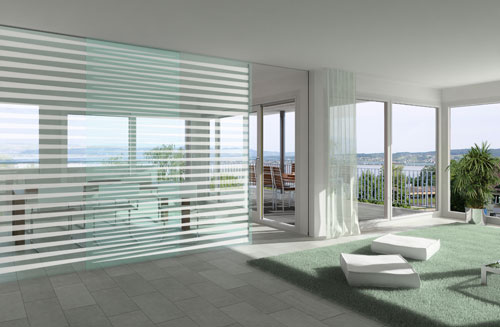 |
Today's sliding hardware systems offer designers a partitioning solution that delivers aesthetic appeal, reliably smooth and silent motion, and significant space savings over the traditional hinged or pivot doors. Image courtesy Hawa Americas Inc. |
Sliding Doors
Sliding doors can be used in place of hinged or pivot doors, providing the same space division and functionality with a much smaller operational footprint. These doors can slide into recessed pockets to be concealed from view when open, or simply slide out of the way, remaining visible in both open and closed positions.
Any number of configurations and types of panel movement are possible to create with sliding doors simply by adding additional door panels or tracks. A single panel on a single track will slide in a straight or curvilinear path. Two panels on a single track can create a bi-parting system where the two doors open from the middle like a theater curtain. Bi-directional, also referred to as bi-passing, systems are created with the use of two or more tracks, allowing the doors to slide fully back and forth along their own track, without the risk of bumping into another panel.
Sliding hardware systems can also be designed to provide symmetric and telescopic sliding movement. Symmetric movement describes a system where two panels always open or close together. The two panels will simultaneously open or close when only one is operated. Telescopic movement also describes two or more panels being moved simultaneously, but with telescopic movement the panels move in the same direction, so two or more panels would move to the right or to the left when opening or closing. This type of movement can be particularly useful when the opening is larger than the available panel parking area.
Folding Walls
Folding walls offer a dynamic alternative to standard stationary walls. Folding wall systems combine as many hardware panels as necessary to create a structure that is the right size to provide subdivisions or window fronts within a space and then retract by folding accordion style, leaving an open space for larger meetings or receptions.
Stacking Walls
Stacking wall systems also subdivide a space by combining multiple hardware panels. The fundamental difference between folding walls and stacking walls is that while folding walls retract with an accordion-like fold, stacking walls retract along a curvilinear track that parks the individual panels to one side or another, like closely stacked dominos, in an orientation that is either parallel or perpendicular to the stacking wall when it is deployed. The ability to precision-park the individual panels, when not in use, creates significant space savings when storing these sizeable and dynamic partitioning walls.
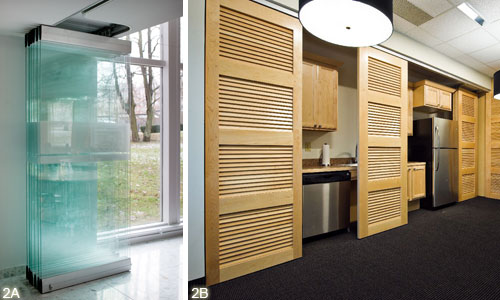 |
When retracting, stacking wall systems park individual panels in an orientation that is either perpendicular (shown in image 2a) or parallel (shown in image 2b) to the deployed stacking wall. Image courtesy Hawa Americas Inc. |
Folding and Stacking Wall Systems
It should be mentioned that folding wall systems and stacking wall systems are both capable of incorporating a pivot door. With a stacking system, a pivot door can be incorporated in a variety of places along the wall in either a central location or at either side. While a folding wall offers slightly fewer placement options, a pivot door is still easily incorporated at either end of the system.
Sliding Exterior Shutters
Sliding exterior shutters provide daylight and thermal control in a way that can also add an interesting aesthetic element to the exterior of a building. These shutter systems can be designed to park adjacent to the opening, fold closed in the same way a closet door folds closed, or slide from view into a recessed parking area.
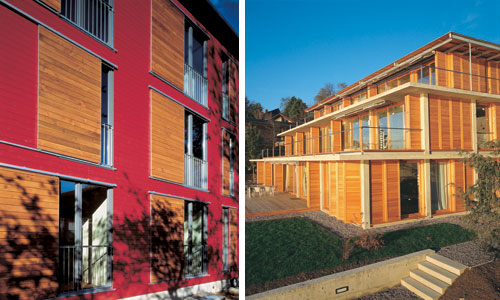 |
Exterior shutter systems can be designed to park adjacent to the opening, fold closed in the same way a closet door folds closed, or slide from view into a recessed parking area. Image courtesy Hawa Americas Inc. |
Sliding Furniture Panels
Sliding furniture panels can be used to replace traditional cupboard, pantry or closet doors with an interesting and aesthetic solution that saves space. Cabinet fronts that fold away, panels that gently roll aside, or scissor-hinged doors that pivot and slide out of sight in one smooth sweep are just three examples of how sliding furniture panels can enhance a space.
The Benefits of Architectural Sliding Hardware Systems
Architectural sliding hardware systems can deliver space savings that translates into real cost savings and improve the accessibility, flexibility, and aesthetics of a space.
Significant Space Savings
A traditional hinge-and-pivot door requires that a space accommodate not only the door, but also the swing that the door makes as it transitions from open to close. Consider that an average interior door in the United States is approximately 32-in. wide by 80-in.tall. The swing space required to accommodate a door of this size is significantly larger than the physical door itself. In a scenario where the average-size door makes a full 180 degree swing on its hinge from open to closed, that door requires that 2048 square inches (over 14 square feet) be left free and clear just to ensure that the door has the space to function properly.
In stark contrast, a sliding door eliminates the need to reserve swing space in the design footprint. For the sliding door to fully move from the open to closed position, the door must be able to slide into an adjacent space that is the same size as the door. If the average door size is 32-in. wide by 80-in. tall by 2-in. thick, the space that must be reserved for deployment is an additional 32-in. wide by 80-in. tall by 2-in. thick and this space most often is reserved along an existing wall or inside an existing wall, if the sliding door is recessed.
As this example illustrates, a sliding hardware door requires a fraction of the space to operate when compared to a hinge-and-pivot door and there is a much smaller opportunity for the door to be impeded if the area is obstructed in any way.
Cost Savings
The significant space savings created by switching from a traditional pivot door to a sliding hardware system can translate into real cost savings for building owners. Imagine being able to design office spaces without being required to set aside a sizeable square footage to accommodate the swing of the hinged door. Eliminating the reserved door space from the typical 10-ft by 15-ft office with the use of a sliding door enables a floor plan to yield substantially the same usable office space in a 10-ft by 12-ft footprint instead. That returns 30 square feet per office to the floor plan to be able to be used for something else. That represents 20 percent of the initial 10-ft by 15-ft office space.
With this more efficient use of office space, building owners may be able to meet their office needs with a smaller, less costly space or turn the saved space into a conference area or common area that would add value to the work space.
Improve Accessibility
The ADA Accessibility Guidelines for Buildings and Facilities (ADAAG), section 4.13.11 regarding door opening force, mandates that the maximum force for pushing or pulling open an interior hinged door shall be 5 lbf (22.2N) and that the maximum force for pushing or pulling open a sliding or folding door shall also be 5 lbf (22.2N). Many sliding systems on the market today satisfy these ADA requirements and improve the overall accessibility of the space for people with disabilities. Today’s hardware requires very little force to operate, but the most fundamental improvement offered by a sliding system is that there is no pivoting door to maneuver around, a movement that can be cumbersome for a person in a wheelchair or with limited mobility. Instead of trying to accommodate the door’s range of motion, which may require a person to back out of the way while the door swings open or awkwardly navigate out of the arc of motion in order for the door to close, a sliding door simply slides open, allows a person to enter a space as if they are walking through an arch, and then closes behind them.
Improve Space Flexibility
Sliding doors and wall systems help create flexible spaces that can be easily rearranged to accommodate different uses of a space. A large room can be subdivided into conference rooms and reception areas and then opened up for a larger office-wide meeting or presentation. Traditional doors and walls leave little wiggle room for easy space shifting. The walls in particular typically require a sledgehammer to remove and drywall, a contractor, and time to replace.
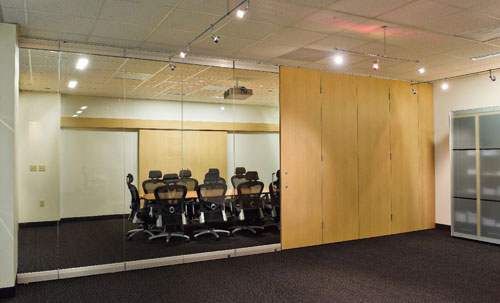 |
This combination glass and wood sliding wall deploys to create a conference room, when needed, and then retracts to open up the space for common use. Image courtesy Hawa Americas Inc. |
Minimize Safety Hazards
There are a variety of potential safety hazards in a bustling commercial and institutional setting. While hot coffee, slippery floors, and stairwells may be the most infamous, pivot doors can cause a problem when they are pushed open into an unsuspecting person on the other side. Add hot coffee, a slippery floor, or a stairwell and the potential problem quickly gets exponentially worse. Sliding hardware systems minimize this potential safety hazard, simply sliding out of the way, instead of swinging into a colleague or coffee-carrying co-worker.
Add Architectural Interest
The wide range of panel materials and the smooth motion of the sliding hardware systems can be used to create a space that looks and feels very different from the traditional wall and pivot door solution. Sliding systems with glass, wood, or metal panels can create a flowing and modern aesthetic to an otherwise traditional office or residential space.
Improved Daylight Control and Curb Appeal
Sliding exterior shutters help prevent glare and thermal heat gain by controlling the daylight that enters the interior space. They also provide better aesthetic control for designers trying to avoid the pitfalls that can be experienced after specifying interior shading systems. Exterior shutters offer a more consistent look by eliminating the opportunity for individual building occupants to modify the position of the shutter. Interior shades are often manipulated by different individuals who can cause one interior shade to be open, the next to be closed, the next to be deployed half-way, etc. This inconsistency can create a messy façade. Exterior shutters provide a more universal solution that protects the aesthetic integrity of the building’s exterior.
Applications for Sliding Hardware Systems
Create More Flexible Office Spaces with Sliding Systems
A common application for sliding hardware systems is to use these systems to separate a larger office area into a combination of conference rooms and common areas that can then be opened up to accommodate a larger reception or office-wide meeting. In these settings, using a sliding hardware system instead of stationary walls enables the office space to easily morph to accommodate the changing needs of the company and to maximize the potential of the facility’s square-footage. Storage space is minimal with the sliding and stacking systems, keeping the majority of the floor plan available for whatever customer demands and organizational innovation may arise.
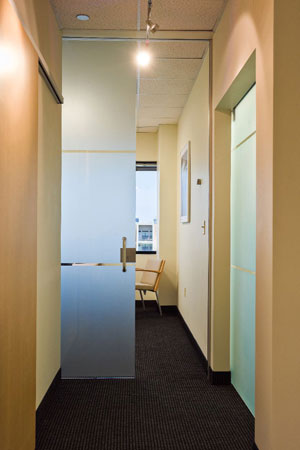 |
Sliding office doors require a fraction of the footprint used by the traditional pivot door, making them a wonderful solution for architects trying to do more with less space. Image courtesy Hawa Americas Inc. |
Sliding Doors Replace Pivoting Doors
In private offices, conference rooms, break rooms, and bathrooms, the traditional hinge-and-pivot door is being replaced by the more space conscious sliding door. There are a number of reasons that these slide-for-pivot swaps are occurring. Companies are looking to squeeze every last drop of efficiency from their resources, including their office space. Sliding doors need a fraction of the functional footprint required by a hinged door to open and close appropriately. Companies can use the newfound square footage to address a competitive need that better enables them to deliver value to their customers or improve the work environment for their employees. Architects are using sliding doors to fit more office space into a smaller footprint, saving their customers money as they rent or purchase the necessary real estate.
Sliding Hardware in Hospitality Applications
Sliding doors have proven to be a particularly good solution for separating the bathroom from the main guest room in a hotel. The sliding doors provide the same privacy and sound barrier that a pivot door provides, with the additional benefit of space savings that can be quite noticeable in the small footprint of a guest room. The pivot doors require that a significant amount of space be left free and clear, just so the bathroom door may open and close correctly. Sliding doors do not require the same reserved space, freeing up guest room space and, overall, improving the guest experience.
Sliding hardware systems are also frequently used to separate common areas in hospitality applications, providing a facility with the ability to easily manipulate a space to accommodate a larger number of events with various square footage needs. The sliding systems can be deployed to divide a large area into smaller areas enabling the facility to meet the space and budgetary needs of smaller events and then easily retract to open the larger space up for conventions or corporate conferences.
Sliding Hardware Systems in Healthcare
Hospitals are also recognizing the benefits of using sliding hardware doors for bathroom doors. The sliding door is easier for a person in a wheelchair or a person with limited mobility to navigate. It can be difficult for people trailing medical equipment or in a wheelchair to maneuver around a pivot door as it opens and closes. Sliding doors offer a simplified entrance: sliding open, allowing the patient or visitor to cross the threshold of the bathroom, and then sliding closed behind them.
Residential Applications
Whether it’s a small studio apartment or home that simply lacks a separated dining area, there are many residential spaces that benefit from being able to camouflage the kitchen. A sliding wall can create the desired division between the dining area and the kitchen, enabling hosts to hide the dinner mess when entertaining family and friends, without permanently compartmentalizing a larger residential space.
Sliding architectural systems add value and intrigue to a residential space by customizing open floor plans with dynamic partitioning and providing privacy at bathroom entryways. Image courtesy Hawa Americas Inc. |
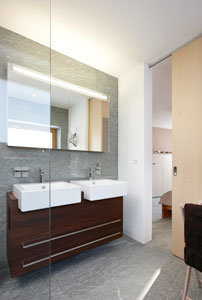 |
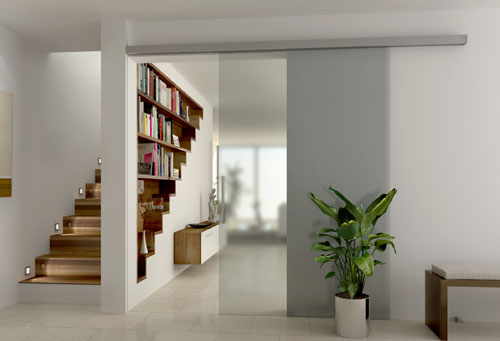 |
|
These sliding systems can also be used to hide away kitchenettes and laundry areas when not being used and allow access to the equipment without filling the space with opened pivot doors that create visual clutter and take up space.
Sliding architectural systems also add value to a residential space by providing privacy at bath entryways, customizing open floor plans with dynamic partitioning, and replacing traditional cupboard, pantry and closet doors with sliding furniture panels.
Control Daylight in Glass Doors or Large Windows
Exterior shutters can be used to control the daylight that streams through glass doors or large windows in commercial or residential applications. These daylight control products are especially important in areas that are prone to the intense, direct light rays that can cause glare and thermal heat gain, making an interior space uncomfortable.
Basic Sliding Hardware System Components
When specifying a sliding hardware system, it is important to understand the various components that will need to be selected. The basic components that comprise a sliding hardware system are: the panels, the track, the trolley, the suspension, the door guide or floor guide, door stop, and auxiliary hardware, if necessary.
Panels
Hardware panels are the physical material panels that create the door or wall that will divide the space. These panels are available in a variety of materials including glass, wood, metal, a manufactured material or a combination of any of the aforementioned.
 |
The box type track encloses the trolley and makes it impossible for the system to jump the track. Image courtesy Hawa Americas Inc. |
Track
The track for sliding hardware systems today is one of the areas where technology has improved dramatically over the poorly performing systems of the past. Where previous systems were susceptible to jumping the track, causing the door to work incorrectly, a type of track, called a box type, has been developed which makes jumping the track impossible.
Tracks are available in three shapes. The box type safeguards the sliding system from jumping the track. The I shape is used for sliding systems that will slide in a straight and linear path. The C shape is designed to allow for curves and turns in the track path.
Trolley
The trolley, also referred to as a carrier, is a wheeled carriage device that travels along the track. It was the trolley that would jump the track in those older sliding door models. In the box type track, the trolley is completely enclosed in the box-shaped track eliminating the possibility that it could jump outside of the track and interfere with the functionality of the system.
Suspension
The suspension connects the individual hardware panels to the trolley and can be visible or concealed, depending upon the specific mounting style selected. It should be noted that the suspension could be incorporated into the trolley, depending upon the manufacturer.
Door Guide or Floor Guide
A door guide, also referred to as a surface guide, is used on straight or curved sliding door systems to keep the sliding door panels from swinging back and forth or rattling in response to vibration in the space or airflow. The door guide provides a barrier-free threshold and could be mounted on the floor or wall.
A floor guide is a physical track in the floor that is required if the hardware panels of the system are heavy enough or large enough to necessitate the additional control mechanism. These floor guides are available for sliding, stacking, and folding systems and should be considered where the panel slides more than its own width or if the height to width ratio of the panel is too large to avoid sway from occurring at the unguided end of the panel.
Door Stop
Doorstops keep the sliding door panels from sliding too far and colliding into the adjacent walls or other system panels. There are three areas where doorstops are popularly placed. They can be placed inside the track, floor mounted, or mounted on the wall.
Auxiliary Hardware
Depending upon the specific project, handles and locks may need to be specified for the system. These auxiliary hardware components are typically available in a variety of styles and finishes to meet the specific preferences of the design team.
Three Items to Consider When Specifying a Sliding Hardware System
It is important that the sliding hardware system specified onto a project be capable of delivering both the expected functionality and the desired aesthetic appeal. To that end, there are three critical decisions that must be made when selecting the best sliding hardware system for any specific project. The system must be specified as either a top-hung system or a bottom rolling system. If glass panels will be the material used in the system, the architect must decide whether to use machined glass or non-machined glass. And finally, the mounting methodology must be selected.
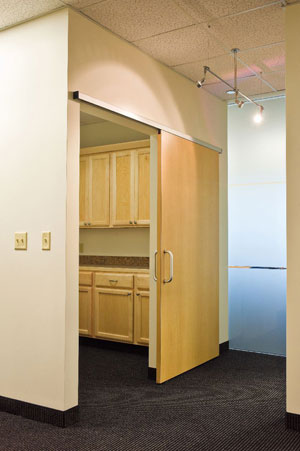 |
In top-hung systems, the top track supports the weight of the panels. Image courtesy Hawa Americas Inc. |
Top-Hung Systems vs. Bottom-Rolling Systems
Both top-hung and bottom-rolling sliding systems are comprised of the same basic components. The difference between the two systems is where the weight of the panels is supported. In top- hung systems, the top track supports the weight of the panels. In bottom-rolling systems, the panel weight is supported by a track in the floor.
Top-hung systems can provide a smoother movement more reliably, can accommodate curvilinear movement and curved panels, and offer an overall cleaner aesthetic, but top-hung systems do have load capacities that can limit the size and weight of the panel materials used. The more reliably smooth operation is a product of the type of track used in top-hung systems and the use of the ceiling, instead of the floor, as the foundation for the track. Some top-hung systems employ the box type track ensuring that the trolley remains in contact with the track at all times and eliminating the possibility that performance will be impeded by the trolley jumping the track. And since the top-hung track is mounted on the ceiling, the rolling action of the system is not affected by unlevel floor conditions. In terms of cleaner aesthetics, top-hung systems can be concealed into the ceiling, leaving no visible sign of the mounting hardware, and they do not require a bottom track, allowing for the space to maintain a clear threshold.
Top-hung system load capacities will differ by manufacturer and panel material, so when specifying a sliding hardware system, please be sure to check the load capacities of the specific system being considered. For illustrative purposes, here is a general range of top-hung system load capacities by panel type. A top-hung system can support a glass panel weighing between 88 lbs. and 1100 lbs., a wood panel weighing 88 lbs. up to 1100 lbs., a metal panel weighing between 176 lbs. and 1100 lbs., and a combination glass and wood furniture panel weighing from 33 lbs. up to 176 lbs.
A bottom-rolling system provides a very high load capability, allowing for very heavy or very large panels to be used in a space, without requiring complex hardware for support. In a bottom-rolling system, a bottom track is surface-mounted or mortised into the floor and the panels open and close by rolling along that bottom track. The location of the track in the bottom-rolling system can create some functional and aesthetic issues that a specified should be aware of. There is also the possibility that the rolling elements of a bottom rolling system will jump the track, affecting performance. Aesthetically, these systems do require a track to be placed in the floor, which will be visible, and the rolling movement can be impaired if the floor track is contaminated or blocked. Bottom-rolling systems are also susceptible to uneven floor surfaces, which can cause the system to tilt in one direction or the other, if not correctly leveled.
Machined Glass Panels vs. Non-Machined Glass Panels
If glass is selected as the panel material for a sliding hardware system, the designer or design team will need to choose between installing a machined glass panel or a non-machined glass panel. There are essentially two ways to mount a glass panel into an architectural sliding system. One is to drill holes or cutouts into the glass, a process called machining, which enables the mounting mechanism to be stuck through the glass panel and attached to the system. The other way to affix the glass panel to a sliding system is to select a clamp-style mounting where the mounting hardware clamps onto the glass, holding it in place.
While the clamp will mount a glass panel that has not been machined, or non-machined glass, there is a risk of the glass falling out of the clamp as the prolonged movement of the system combined with the weight of the panel can cause the glass panel to shift and vibrate. With machined glass, the mounting hardware does not physically mount to the glass, but instead attaches to the mounting mechanisms that have been slid through the holes or cutouts that have been machined into the glass panel.
Panel-Specific Mounting Options
The way that a panel is mounted to the architectural sliding system will determine whether the mounting hardware is seen or concealed and where the hardware is located. Mounting options are unique to the type of panel material used in the system, so there are different options depending upon whether the specified system is wood, metal, or glass.
Wood Panel Mounting Options
Wood panels can be mounted to a sliding system with a top recessed mount, a top mount or a side mount. A top recessed mount allows the hardware to be concealed in the top edge of the door panel. The hardware will be visible in both the top mount and side mount options. Top mount hardware is mounted and visible on the top of the panel and side mount hardware is mounted on and visible on the inside of the panel.
Metal Panel Mounting Options
Metal panel mounting options are very similar to the wood panel mounting options just described. These panels are typically mounted on either the top of the panel or the side of the panel.
Glass Panel Mounting Options
When specifying a glass panel for a space, transparency is often an aesthetic objective of the design team. The type of mounting selected will impact whether or not the mounting hardware is fully concealed or visible and to what degree.
 |
The type of mounting selected for a glass panel system will determine if the mounting hardware is fully concealed or visible and to what degree. Image courtesy Hawa Americas Inc. |
Frameless
In a frameless mounting, the hardware is fully concealed in the track, preserving the transparency provided by the glass system. This mounting style requires machined glass and can be used with either tempered or laminated glass.
Patch Fitting
The patch fitting mounting style requires machined glass and provides minimal hardware exposure. This mounting option can be applied to both tempered and laminated glass.
Suspension Profile
In a suspension profile mounting, the suspension hardware is hidden behind the cover profile and minimal hardware is exposed. This mounting style also requires machined glass.
Framed
The framed mounting style frames the glass panel on all four sides and provides rigidity for tall glass panel applications. This style does not require machined glass.
Friction Clamp
A friction clamp mounts glass panels without requiring that they undergo the machining process. This mounting option is not suitable for panels that weigh more than 220 lbs. and is not recommended for use with laminated glass.
 |
Hawa Americas Inc is the U.S. subsidiary of Hawa AG, a Swiss company renowned internationally as a specialist and leading manufacturer of innovative sliding hardware. Hawa systems can be seen at some of the best addresses in the world. The company has a high-quality solution for virtually any requirement, any material and any door weight, from sliding doors for furniture and buildings to sliding shutters and highly complex sliding wall systems. Over the past forty years, Hawa has developed a multitude of technically high-class systems for folding, sliding, or stacking doors and walls made of wood, glass and metal. www.hawa.com |
